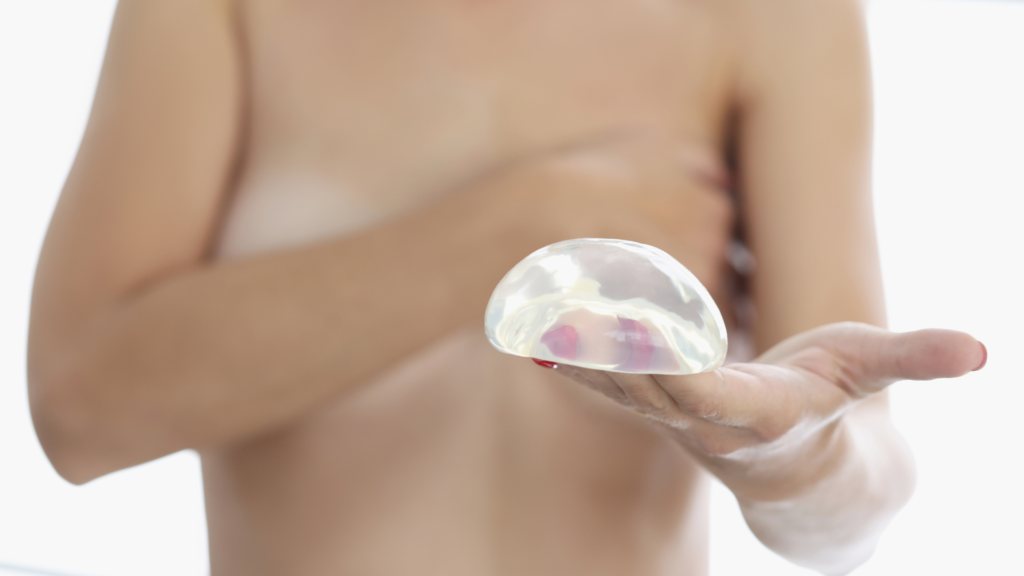We get it. We’re all busy these days. Here are the TL;DR bullet points of saline vs. silicone implants.
Pros and Cons, Cost, and Safety
- Silicone implants are known for their natural look and feel, and are soft to the touch.
- Saline implants are firmer, but are also slightly more lightweight and affordable.
- Both types of implants will last between 10 and 20 years.
- Saline implant ruptures are usually harmless, but silicone ruptures can sometimes cause side effects such as swelling, soreness and structural changes to breast tissue.
- Bottom line: When choosing between saline and silicone gel implants, there are a number of factors to consider. If you’re still undecided, schedule a consultation with Dr. Bloom.
If you have a little more time…take a deeper dive.
Difference between silicone and saline implants
Many women are interested in breast implants to make their breasts fuller and more prominent. This procedure, which can be paired with a breast lift, may be done for cosmetic or reconstructive reasons. Let’s break down the differences between silicone implants and saline implants.
Silicone gel
Silicone gel is an inert polymer with no known human allergies, sensitivities or reactions. Like a gummy bear candy, the molecules are stuck to one another in a cohesive matrix. Silicone is more viscous than saline. In contrast to saline, it flows differently within its shell and can often create a more natural look and feel to the breast, like breast tissue. Women must be 22 years of age or older to be offered silicone gel implants for breast augmentation, as per the FDA’s regulations.
Over the last 20 years, significant advances have been made to silicone gel implants. In fact, we are now implanting the 7th and 8th generation of silicone breast implants. The newest silicone implants have a slightly higher fill (96% fill versus the previous generation’s 85% fill) and more cross- linking of the silicone molecules, increasing the stiffness or “cohesiveness” of breast implants.(source: plasticsurgery.org)
Saline (sterile salt water)
Saline implants have been used since the 1960s. They have an outer shell made of silicone, but the shell is inserted empty. It’s then filled with sterile salt water, which means the incision site is often smaller and less noticeable. Saline implants are typically a bit less expensive than silicone.
Saline-filled implants are available to all women for breast augmentation over the age of 18. A silicone shell is inserted into the body and then filled to its desired volume by a board-certified plastic surgeon with saline fluid. Saline has the consistency of water. Underneath very thin skin, folds of a saline implant might be seen or felt more often – this is known as implant “rippling” or “wrinkling.”
Some saline implants have the advantage of being postoperatively adjustable via a remote injection port – this is commonly used in some types of breast reconstruction procedures to fine-tune the final implant volume over months before the implant port is removed.

Safety Comparison
DID YOU KNOW? Silicone gel breast implants are the most widely studied medical device in the history of medical devices.
With all implants, there is a risk that it will one day rupture. In other words, it may develop a tear in the silicone shell. Saline and silicone implant ruptures carry different levels of risk. When saline implants rupture, the salt water solution is safely absorbed by the body.
With silicone implant ruptures, any gel that leaks out will remain trapped within the capsule that naturally forms around an implant. This prevents it from being absorbed by the body leading to soreness, swelling and changes to the shape and texture of the breast tissue. As such, ruptured silicone implants do not noticeably deflate, making ruptures difficult to detect visually.
That being said, routine mammograms, diagnostic ultrasounds and screening MRIs are generally quite effective at detecting implant ruptures. Overall, health concerns due to ruptures of either type of breast implant are very rare.
Cost comparison
In most cases, breast implants are considered elective cosmetic surgery and aren’t covered by insurance. Implants should not be considered permanent, and many people routinely get them replaced or removed every 10-15 years.
Silicone implants are more expensive than saline
When combined with a lift, breast implant surgery can cost as much as $12,000, and silicone implants are around $1,000 more expensive than saline. You also have to consider the cost of follow-up MRIs, which are recommended every few years to make sure silicone implants have not ruptured.
Bottom Line
Breast augmentation surgery comes with a wide range of choice: implant type, size, incision location, implant placement, adding a lift, and more. For you, the patient, that’s good news! It might make for a more complex consultation than you thought but it gives you more control over your results.
Based on your breasts, body type and other factors, Dr. Bloom will work with you to recommend which type of implant over another for better results.
